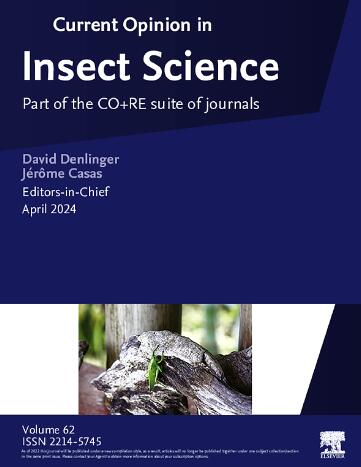Innovations in Varroa mite management
IF 4.8
1区 农林科学
Q1 BIOLOGY
引用次数: 0
Abstract
Varroa mites, the main pest of honey bees, are notoriously difficult to control. We present a novel approach to mite management emphasising the role of immigration. We argue that how mite numbers increase within the colony determines the most effective varroa management techniques. That is, varroa infestations go through phases, where their rate of increase is either driven by varroa reproduction (Chronic phase) or is strongly influenced by immigration into the hive (Acute phase). Identifying chronic and acute phases will enable current varroa control methods to be better targeted. For example, control methods reducing reproduction rates will be most effective during the chronic phase. Identifying when immigration is important to varroa in-hive population increases (acute phase) may enable existing bee management techniques, for example, those that limit the access of some bees into hives, to be co-opted into varroa management. This change in perspective emphasises that in-hive varroa control will be improved by understanding the subtleties of how and when varroa enter hives; it will also identify other gaps in our knowledge of varroa’s behavioural ecology that could lead to new varroa control methods. Therefore, this novel approach to mite management will enable Integrated Pest Management to be better tailored to this pest.
螨虫管理的创新。
蜜蜂的主要害虫瓦螨是出了名的难以控制。我们提出了一种新的方法来螨虫管理强调移民的作用。我们认为螨虫数量如何在种群内增加决定了最有效的螨虫管理技术。也就是说,varroa侵扰会经历几个阶段,在这些阶段中,它们的增长速度要么受到varroa繁殖(慢性期)的驱动,要么受到蜂房移民的强烈影响(急性期)。确定慢性和急性阶段将使目前的瓦螨控制方法更有针对性。例如,降低繁殖率的控制方法在慢性期将是最有效的。确定何时移民对蜂房内蜂群的增加(急性期)是重要的,可以使现有的蜜蜂管理技术,例如那些限制一些蜜蜂进入蜂房的技术,被纳入蜂房管理。这种观点的改变强调,通过理解蜂虫如何和何时进入蜂箱的微妙之处,将改善蜂箱内的控制;它还将确定我们对瓦罗亚行为生态学知识的其他空白,这些空白可能会导致新的瓦罗亚控制方法。因此,这种新的螨虫管理方法将使害虫综合管理能够更好地针对这种害虫。
本文章由计算机程序翻译,如有差异,请以英文原文为准。
求助全文
约1分钟内获得全文
求助全文
来源期刊

Current opinion in insect science
BIOLOGYECOLOGYENTOMOLOGY-ECOLOGY
CiteScore
10.40
自引率
1.90%
发文量
113
期刊介绍:
Current Opinion in Insect Science is a new systematic review journal that aims to provide specialists with a unique and educational platform to keep up–to–date with the expanding volume of information published in the field of Insect Science. As this is such a broad discipline, we have determined themed sections each of which is reviewed once a year.
The following 11 areas are covered by Current Opinion in Insect Science.
-Ecology
-Insect genomics
-Global Change Biology
-Molecular Physiology (Including Immunity)
-Pests and Resistance
-Parasites, Parasitoids and Biological Control
-Behavioural Ecology
-Development and Regulation
-Social Insects
-Neuroscience
-Vectors and Medical and Veterinary Entomology
There is also a section that changes every year to reflect hot topics in the field.
Section Editors, who are major authorities in their area, are appointed by the Editors of the journal. They divide their section into a number of topics, ensuring that the field is comprehensively covered and that all issues of current importance are emphasized. Section Editors commission articles from leading scientists on each topic that they have selected and the commissioned authors write short review articles in which they present recent developments in their subject, emphasizing the aspects that, in their opinion, are most important. In addition, they provide short annotations to the papers that they consider to be most interesting from all those published in their topic over the previous year.
 求助内容:
求助内容: 应助结果提醒方式:
应助结果提醒方式:


